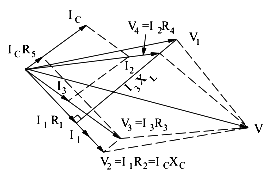The circuit diagram and voltage vector diagram are shown in Fig..

As seen, I2 is vector sum of IC and I3.
Voltage V2 = I2 R2 = IC XC.
Also, vector sum of V1 and V2 is V as well as that of V3 and V4. IC is at right angles to V2
Similarly, V3 is the vector sum of V2 and ICR5.
As shown in Fig.,

R1 = R2 x R4/R3 = 50 x 100/100 = 50Ω
The inductance is given by
L = CR2(R4 x R5 x R4R5/R3)
∴ L = 1 x 106 = 50(100 x 2500 x 100 x 2500/100)
= 0.2505H